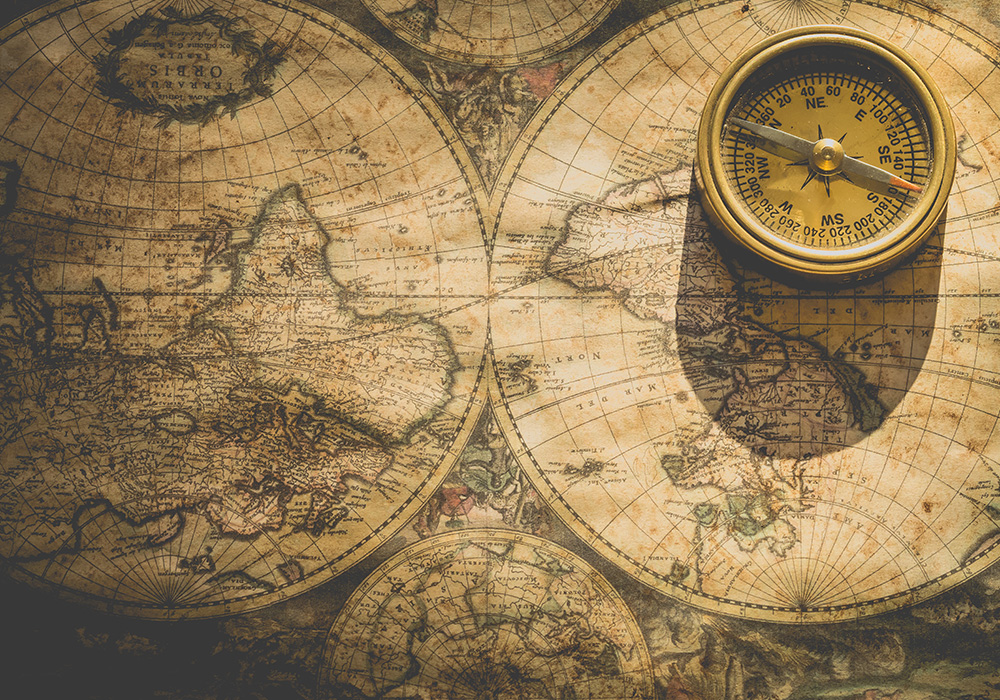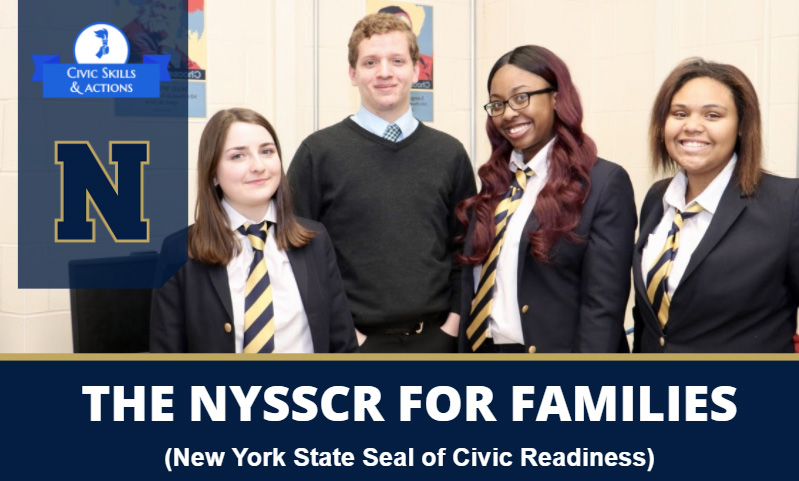Social Studies Department

Our Vision
Our goal as a department is to educate students to think critically. Our scholars must learn the skills to investigate historical events, documents, media and current events with an analytical and evaluative eye. As a department, we hope to instill within our young people the ability to form their own conclusions through the compilation of evidence, fact and historical context. Ultimately, our graduates will leave academy field as informed and civically engaged citizens, ready to participate in democracy and impact society for the betterment of humanity. The role that a strong education in the Social Studies plays in the lives of our Goldbacks will be measured by their actions and character.

Social Studies Program
Our K-12 program and curriculum follow the New York State Social Studies Framework K-8 and 9-12 and are embellished with a wide array of Open Educational Resources (OER’s) including but not limited to:
Teaching Tolerance
Facing History and Ourselves (FHAO)
New Visions
Stanford History Education Group (SHEG)

NYS Seal of Civic Readiness
The Seal of Civic Readiness is a new initiative supported by the NYS Department of Education. In order to earn a civics seal, students have to earn a total six points through various schoolwork and outside activities that demonstrate their knowledge of civics, as well as civic engagement.

Contact Social Studies
Carolyne Monereau-St. Louis, Director of Humanities K-12
BOE/Library Complex
124 Grand Street, Newburgh, NY 12550
Social Studies Curriculum
- Basic awareness of self as an individual
- Describes how each person is unique and important
- Identifies family members, family characteristics and functions
- Describes his/her own community
- Demonstrates awareness and appreciation of their own culture and other cultures
- Demonstrates an understanding of roles, rights and responsibility at home, school and in the community
- Myself and others
- My family and other families
- My school and community
- My neighborhood
- Location of home, school, neighborhood, and community on maps and globes
- Basic human needs and wants
- People helping one another to meet needs and wants
- Symbols of citizenship
- Rights, responsibilities and roles of citizenship
- People making and changing rules and laws
- People making rules that involve consideration of others and benefit all
- My family and other families
- History of my family
- My community local region
- Places in my community and local region
- Challenge of meeting needs and wants
- Economic decision making
- Symbols of citizenship
- Rights, responsibilities and roles of citizenship
- People making and changing rules and laws
- My community and region today
- People depending on and modifying the physical environment
- Challenge of meeting needs and wants
- People using human, capital, and natural resources
- Economic decision making
- Symbols of citizenship
- Rights, responsibilities and roles of citizenship
- People making and changing rules and laws
- Cultures and civilizations
- Communities around the world
- The location of world communities
- Physical, human, and cultural characteristics of world communities
- People depending on and modifying the physical environment
- Challenge of meeting needs and wants in world communities
- Economic decision making in world communities
- Symbols of citizenship in world communities
- People making and changing rules and laws
- Governments around the world
- Native American Indians of New York State
- Three worlds (Europe, the Americas, Africa) meet in the Americas
- Colonial and Revolutionary periods
- The Revolutionary War in New York State
- The new nation
- Industrial growth and expansion
- Urbanization: economic, political and social impacts
- Government
- Purposes of government
- Local and state governments
- History of the United States, Canada, and Latin America
- Geography of the United States, Canada, and Latin America
- The economies of the United States, Canada, and Latin American nations
- The governments of the United States, Canada, and Latin American nations
Grade 6: The Eastern Hemisphere
• History of Eastern Hemisphere nations
• Geography of Eastern Hemisphere nations
• Economies of Eastern Hemisphere nations
• Governments of Eastern Hemisphere nations
In Grades 7 and 8, students will examine the United States and New York State through a historical lens. The two-year sequence is arranged chronologically beginning with the settlement of North America by Native Americans and ending with an examination of the United States in the 21st century. Although the courses emphasize the skill of chronological reasoning and causation, the courses also integrate the skills and content from geography, politics, economy, and culture into the study of history.
Grade 7 Social Studies is arranged chronologically and incorporates geography as well as economic, social, and political trends. The course content is divided into eight Key Ideas, tracing the human experience in the United States from pre-Columbian times until the Civil War, with a focus on the people, events, and places in New York State as applicable.
Grade 8 Social Studies is arranged chronologically beginning with Reconstruction and ending at the present and incorporates geography as well as economic, social and political trends. The course content is divided into nine Key Ideas; the first seven trace the human experience in the United States from Reconstruction to the end of World War II. The last three Key Ideas examine different themes in United States and New York history from the post-War period up to the present day providing the opportunity to explore contemporary issues.
Global History and Geography
The program for grade nine begins a two-year global history course organized chronologically. Grade 9 begins with earliest civilizations through 1700. The emphasis is thematic, with a strong focus on global relationships. Essay writing and document analysis skills are developed throughout the course
Global History and Geography II
The program for grade 10 concludes the two-year global history course begun in 9th grade. The course is organized chronologically. Grade 10 focuses on the period after 1700. This course emphasizes geography, history, economics, and global relationships as well as essay writing and document analysis skills.
AP World History
The Advanced Placement level course is offered by the College Board. It centers on six overarching themes that describe the global human experience. They serve to connect five unifying historical threads (Foundations, 8000 B.C.E.-600 C.E., 600 C.E.-1450 C.E., 1450-1750, 1750-1914, 1914 to present). The course will devote considerable focus on critical evaluation of primary and secondary sources, oral presentations, research papers, simulations, United States history and government. This is a chronologically organized course in United States history. The emphasis is on the United States as an industrial nation. Constitutional and legal issues are explored, as well as issues of international involvement. Document analysis and essay writing skills are an important focus.
AP United States History and Government
Prepares students for both the N.Y. State Regents exam in U.S. History & Government and the Advanced Placement examination given in May of the school year will be expected. In order to qualify for the program, the student should have a great interest in American History and be prepared for required extensive reading in the content area including supplemental historical books.
United States History and Government begins with the colonial and constitutional foundations of the United States and explores the government structure and functions written in the Constitution. The development of the nation and the political, social and economic factors that led to the challenges our nation faced in the Civil War are addressed. Industrialization, urbanization and the accompanying problems are examined, along with America’s emergence as a world power, the two world wars of the 20th century and the Cold War. Students explore the expansion of the federal government, the threat of terrorism and the place of the United States in an increasingly globalized and interconnected world.
Economics
The course includes basic economic concepts and understandings which all persons need to function effectively and intelligently as citizens and participants in the economy of the United States and the world. It emphasizes a practical understanding of the American economic system and personal finance.
Participation in Government
The course is an introduction to the structure and functioning of government, to the means by which public policy decisions are made and to selected public policy issues in present-day American life.
Social Studies Links
The use of primary sources and other documents should be an integral part of a social studies program. Students should learn how to analyze historical documents and prepare essays and reports that describe different perspectives on various historical issues, events, and questions. Primary and secondary source documents can be found on a number of websites including the following:
Federal Resources for Educational Excellence-Social Studies
Internet History Sourcebook Project
Social Studies Links
| General Sites | |
|---|---|
| The National Council for the Social Studies | Standards, teaching resources (internet, print and videos), and links to social studies web sites. |
| MidHudson Social Studies Council | The Mid Hudson Social Studies Council is a educational non-profit organization. It is affiliated with the New York State Council for the Social Studies (NYSCSS). |
| World History for Us All | a curriculum for teaching world history to middle and high school students. This is project of San Diego State University and involves the collaboration of K-12 teachers and university instructors |
| Education World Social Science Lesson Plans | Education World is a complete online resource that teachers, administrators and school staff can visit each day to find high-quality and in-depth original content. |
| Teach-nology Social Studies Lesson Plans | For over a decade, TeAchnology has been providing free and easy to use resources for teachers dedicated to improving the education of today's generation of students |
| PBS Social Studies | Lesson plans and other materials from PBS |
| Free Educational Resources from the US Government | in many subjects, and there are a very large number in social studies. |
| Social Studies Theme Units | For history, geography, and related Social Studies topics. |
| History and Social Studies Lesson Plans | From EdSitement. |
| Teach with Movies | Lesson plans for using movies in the classroom. |
| 42 eXplore | Teaching ideas and related web sites for a variety of social studies topics. |
| Smithsonian Education | Good web site for teachers, students, and families. It has lesson plans for all subjects. |
| Social Studies Lesson Plans and Resources | links to sites with lesson plans for history, geography, and current events. There is also a section on online activities. |
| Asia for Educators | Lesson plans for history, geography, and literature. This site is by Columbia University. |
| Current Events | |
|---|---|
| CNN Students News | Resources for both students and teachers. |
| New York Times Learning Network | A news quiz and lesson plans. |
| PBS News Hour | News for students and lesson plans for teachers. |
| Time for Kids | Teacher’s page. By Time magazine. |
| C-Span | Topics for the discussion of current events in the classroom. |
| National Geographic News | Current news of geography and other science and social studies topics. |
| The Cyber School Bus | United Nations education portal with information and activities for both current events and geography. |
| Teachable Moment | Activities and resources for the study of current events. |
| Current Events! | Lesson plans from Education World. |
| Electing a President: Lesson Plans on Presidential Primaries | Lesson plans from Education World. |
| Current Events: Helping the Kids Live the Questions | A blog article by Sarah Cooper, May, 2015. Getting middle school students more involved in current events. |
| Geography | |
|---|---|
| Education@NationalGeographic | Online expeditions, lesson plans, free printable maps, and, of course, National Geographic products for sale. |
| Xpeditions | National Geographic site with virtual field trips, lesson plans, and maps. |
| My Wonderful World | A campaign by the National Geographic to improve student knowledge of geography. There are resources here for students, teachers, and parents. |
| Geography Lesson Plans | From Discovery School. |
| Geography Lesson Plans | From Teachers.net. |
| Free Geography Worksheets | for grades K – 6 from TLS Books.com |
| Free State Printables | Worksheets for the states from About.com. |
| Geography Home Page | From About.Com. There is quite a bit of geography information here. |
| World Mapper | These maps are resized based on the subject of interest such as population, age, tourism, exports and imports. By the University of Sheffield. |
| 21 Map Creation Tools for Students and Teachers | This is from Free Technology for Teachers. |
| Nation Master | An excellent site for statistics from countries of the world. Your students will be able to compare education, income, oil consumption, life expectancy, and many other statistics.There are also maps and country information. |
| Google Earth Lessons | Uses of Google Earth in the classroom. |
| Geology.Com | This site has maps and satellite images for the United States and the countries of the world. |
| An Entire Unit of Work on Antarctica | This is a 5th to 6th grade level unit from Edgalaxy |
| K-12 Electronic Guide to African Resources on the Internet | By the African Studies Center of the University of Pennsylvania. |
| Online Map Games | |
| Geography Games for Kids | Online games from KidsGeo. |
| Government - Economics - Civics | |
|---|---|
| Government Lesson Plans | From Teachnology. |
| USA.gov | The US government’s information portal. |
| Lessons on Local Government | This link will take you to high school level lessons. If you click on the menu, you will find lessons for other grades. These lessons have been designed for Colorado, but you could probably use them in any state. |
| Statistics in Schools | Lesson plans for all grades from the U. S. Census Bureau. |
| Learn About Congress | Interactive modules on congress and the government. This site is by The Center on Congress at the University of Indiana. |
| Courts in the Classroom | An interactive, online activity about notable court cases. There are lesson plans. |
| iCivics | A web site for middle school students and their teachers by Justice Sandra Day O’Connor. There are lesson plans dealing with current judicial issues. |
| Best Civics Site for Teachers | web links collected by the Lenore Annenberg Institute for Civics. |
| Elections and Voting Lesson Plans | From Teachology. |
| The Center for Civic Education | Lesson plans are located in the resource section. |



